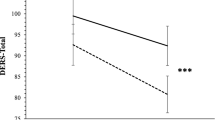Abstract
This paper reports new observations on heart rate and synchrony/desynchrony in the context of 22 chronic agoraphobic patients' trimodal assessment pre and post exposure treatment. The results corroborated previous reports showing weak and/or inconsistent improvement in heart rate, in contrast to significant improvement in behavioral and subjective response systems. Moreover, the results did not support recent suggestions that heartrate reactivity at pretreatment or global categories of synchrony/dysynchrony at posttreatment have important implications for treatment outcome. However, subtypes of dysynchrony based on the direction of divergence between variables had different implications for the clinical response, indicating that simply dichotomizing patients into synchronizers/desynchronizers may be misleading in addition to being uninformative.
Similar content being viewed by others
References
Arena, J. G., Blanchard, E. B., Andrasik, F., Cotch, P. A., & Meyers, P. E. (1983). Reliability of psychophysiological assessment.Behaviour Research and Therapy, 21, 447–460.
Himadi, W. G., Boice, R., & Barlow, D. H. (1985). Assessment of agoraphobia: Triple response measurement.Behaviour Research and Therapy, 23, 311–323.
Holden, A. E., & Barlow, D. H. (1986). Heart rate and heart rate variability recorded in vivo in agoraphobic and non-phobics.Behavior Therapy, 17, 26–42.
Marks, I. M., & Mathews, A. M. (1979). Brief standard self-rating for phobic patients.Behaviour Research and Therapy, 17, 263–267.
Mavissakalian, M., & Michelson, L. (1982). Patterns of psychophysiological change in the treatment of agoraphobia.Behaviour Research and Therapy, 20, 347–356.
Mavissakalian, M., & Michelson, L. (1986). Agoraphobia: Relative and combined effectiveness of therapist-assisted in vivo exposure and imipramine.Journal of Clinical Psychiatry, 47, 117–122.
Michelson, L., & Mavissakalian, M. (1985). Psychophysiological outcome of behavioral and pharmacological treatments of agoraphobia.Journal of Consulting and Clinical Psychology, 53, 229–236.
Michelson, L., Mavissakalian, M., & Marchione, K. (1985). Cognitive and behavioral treatments of agoraphobia: Clinical, behavioral and psychophysiological outcome.Journal of Consulting and Clinical Psychology, 53, 913–925.
Telch, M. J., Agras, W. S. T., Taylor, C. B., Roth, W. T., & Gallen, C. C. (1985). Combined pharmacological and behavioral treatment for agoraphobia.Behaviour Research and Therapy, 23, 325–335.
Vermilyea, J. A., Boice, R., & Barlow, D. H. (1984). Rachman and Hodgson (1974) a decade later: How do desynchronous response systems relate to the treatment of agoraphobia?Behaviour Research and Therapy, 22, 615–621.
Author information
Authors and Affiliations
Additional information
This work was supported by Grants MH34177 and MH40141 from the National Institute of Mental Health. Mary Sue Hamann, M.S., assisted in the statistical analyses.
Rights and permissions
About this article
Cite this article
Mavissakalian, M. Trimodal assessment in agoraphobia research: Further observations on heart rate and synchrony/ desynchrony. J Psychopathol Behav Assess 9, 89–98 (1987). https://doi.org/10.1007/BF00961634
Accepted:
Issue Date:
DOI: https://doi.org/10.1007/BF00961634




